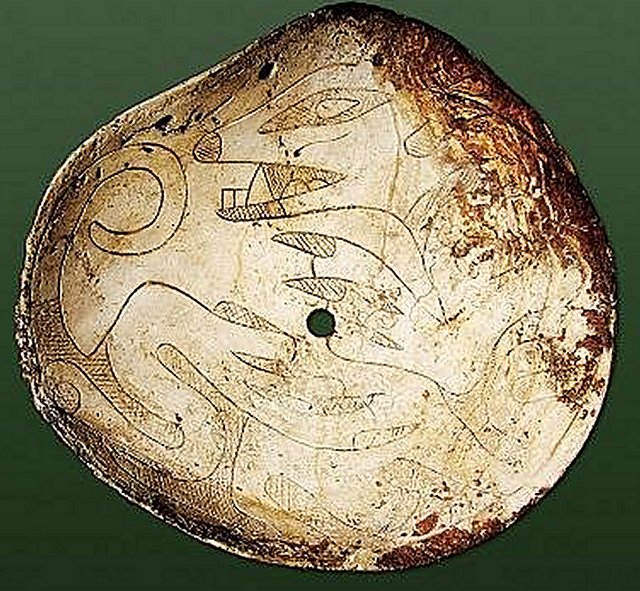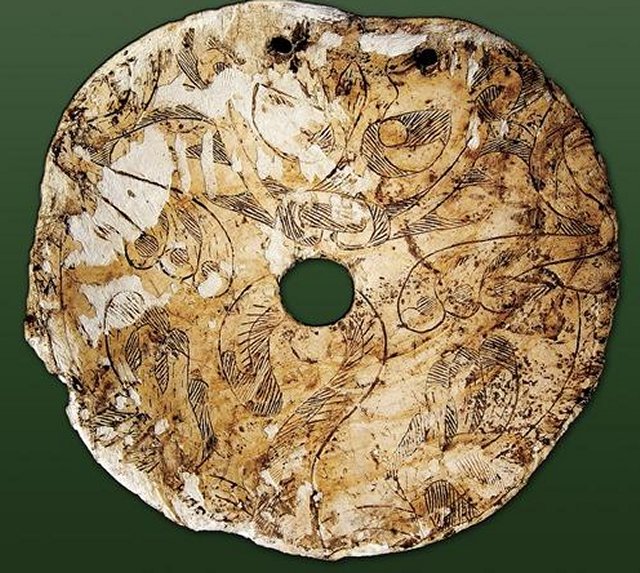MessageToEagle.com – The discovery of a rare Native American artifact in Newtown is exciting for archeologists, but it’s also raising many questions.
On February 13, 2015, a gorget, an ornamental seashell was found in Newtown. The artifact is engraved with an image that appears to be half bird and half cat.
Contractors digging a trench for a fiber optic box north of Newtown’s administrative hall earlier this month found human remains,’ reports WUXU.org.
They called police who quickly realized it was a burial site and not a crime scene. They, in turn, called the Cincinnati Museum Center.

“When the police department actually called us, when I talked to them, he said they found some human remains and he said there was a plate with it. And I kind of knew exactly what he meant because we had found these other two back in 1981,” says Rieveschl Curator for Archeology Bob Genheimer.
Genheimer says the plate is actually a gorget, a decorative seashell, with the image of an animal carved on it.
“A gorget is an ornamental item. These gorgets have three holes in them. They have two at the top for suspension and there’s one in the middle where they possibly could have been attached to clothing or something else,” he says.
“And on the inside, they are engraved.”
Two other gorgets found in Newtown had images of an opossum and a panther carved on them. This one had a hybrid: part bird, part cat.
“Anywhere else in the world, you would refer to this as a griffin. But that’s not something that’s very viable in the Americas.
“We believe that the bird may be a Carolina Parakeet. Which, as many people know, is now an extinct bird, but used to be prevalent in the southern United States and as far north as here,” Genheimer says.
See also:
Mystery Of Yamacutah – A Sacred Native American Indian Shrine
What Was The Symbolism Behind Native American Feathers?
Native American Sun Dance: Important Ceremony Of The Plains Indians Of North America
Tecumseh: Native American Mystic, Warrior, Hero And Military Leader Of The Shawnee
It’s not uncommon to find Native American artifacts around Newtown. The area was home to people for hundreds of years. Genheimer says the gorget dates to the fifth century, and adds to our knowledge of the people who lived in the valley.
“These people lived their lives like anyone else, but they had a little more elaborate ceremonialism when they died, and they would bury things with them.”
“It’s a good question how these got up here. Obviously it’s probably trade. We don’t think anyone from here went down and got them. One of the real questions is where were they engraved? Were they engraved somewhere in the southeast where the shell came from? Or was the shell brought up here and were they engraved here? We really don’t know the answer to that,” he says.
But there are still questions. The shell itself is believed to have come from the Gulf Coast, or the southern Atlantic region.
Remains found with the gorget have been reported, as required by the Native American Graves Protection and Repatriation Act, and could be claimed for reburial by a tribe.
Archeologists at the Cincinnati Museum Center are studying the gorget and hoping to make a replica for display.
© MessageToEagle.com







